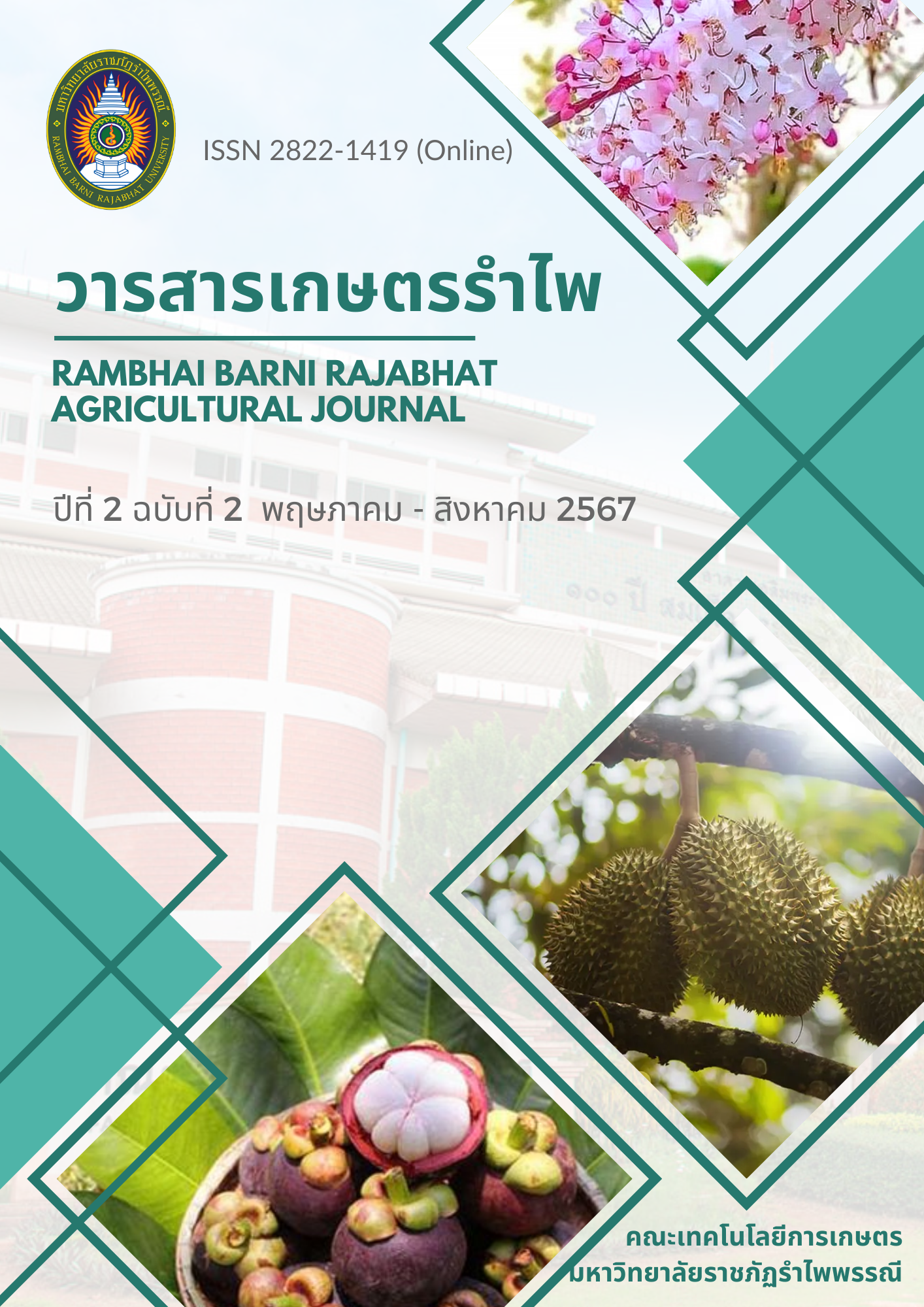Assessment of Vegetative Growth and Leaves Oxalate Contents in Three Sweet Potato Varieties
Main Article Content
Abstract
The objective of this research was to evaluate assessment of vegetative growth and leaves oxalate contents in three sweet potato varieties. The experiment used a factorial experiment in a completely randomized design (factorial in CRD). Factor A consisted of three sweet potato varieties : Purple Sweet Road, Purple Okinawa Beni Imo, and Kuri Beni Imo. Factor B included four levels of sweet potato days of transplanting : 30, 60, 90 and 120 days; a treatment including four replications. Data on main vine length, number of branches, leaf fresh weight, leaf dry weight, chlorophyll fluorescence, leaf area, specific leaf area, and oxalate content were recorded.
The results showed that the cultivars and days after transplanting interacted to affect growth. The Purple Okinawa Beni Imo cultivar at 120 days after transplanting had the highest vine length, fresh leaf weight, and leaf dry weight, as well as the highest chlorophyll fluorescence (0.74). However, in terms of branch number per plant, the Kuri Beni Imo cultivar had the highest number of branches per plant (17 branches) at 120 days after transplanting. Assessment of oxalate content in sweet potato leaves found that the Purple Sweet Road cultivar at 30 days after transplanting had a high oxalate content of 165.63 mg/g FW. This was followed by the Purple Okinawa Beni Imo cultivar and the Kuri Beni Imo cultivar at 30 days after transplanting. This study suggests that the Purple Okinawa Beni Imo and Purple Sweet Road tend to adapt well to growth conditions. If one consumes sweet potato leaves, it is advisable to avoid the sweet potato stage at 30 to 60 days after transplanting to reduce the risk factors associated with developing urinary tract stones.
Article Details

This work is licensed under a Creative Commons Attribution-NonCommercial-NoDerivatives 4.0 International License.
References
เฉลิมพล แซมเพชร. (2542). สรีรวิทยาการผลิตพืชไร่. เชียงใหม่ : ภาควิชาพืชไร่ คณะเกษตรศาสตร์ มหาวิทยาลัยเชียงใหม่.
ณภาภัช ใจเพ็ชร ธัญญารัตน์ มังกร วิตรี พรมศร และอนุรักษ์ อรัญญนาค. (2557). ความสัมพันธ์ระหว่างปริมาณคลอโรฟิลล์และผลผลิตชีวมวลของลูกผสมข้ามชนิดระหว่างสบู่ดํากบเข็มปัตตาเวีย. ใน การประชุมวิชาการแห่งชาติ มหาวิทยาลัยเกษตรศาสตร์ วิทยาเขตกำแพงแสน ครั้งที่ 11 (หน้า 1685-1693).
นฤมล ผิวเผื่อน. (2557). ผลึกแคลเซียมออกซาเลต และปริมาณออกซาเลตในพืชผักบางชนิดในจังหวัดหนองคาย. วารสารวิทยาศาสตร์ มหาวิทยาลัยขอนแก่น 42(4) : 820-829.
พัชรินทร์ ชนะพาห์. (2554). ปัจจัยเสี่ยงของโรคนิ่วในไต ประเด็นของสารแคลเซียมและออกซาเลต. สงขลานครินทร์เวชสาร. 29(6): 299-308.
พิชญุตม์ ฤกษนันทน์. (2561). การพัฒนาระบบตรวจวัดแคลเซียมออกซาเลตในปัสสาวะเพื่อการคัดกรองโรคนิ่วไต. วิทยานิพนธ์ ปริญญาวิทยาศาสตรมหาบัณฑิต, จุฬาลงกรณ์มหาวิทยาลัย.
ภานุวัฒน์ สีพันธ์, สกุลกานต์ สิมลา, สุรศักดิ์ บุญแต่ง และ ชฎาพร เสนาคุณ. 2560. ระยะพัฒนาการต่อปริมาณสารพฤกษเคมีและความสามารถในการต้านอนุมูลอิสระในใบมะนาวโห่. แก่นเกษตร (ฉบับพิเศษ), 45(1) : 336-341.
ละอองศรี ศิริเกษร สุชาดา บุญเลิศนิรันดร์ และวชิรญา เหลียวตระกูล. 2561. การเปรียบเทียบการเจริญเติบโตและผลผลิตของมันเทศ 6 พันธุ์. วารสารวิจัยมหาวิทยาลัย เทคโนโลยีราชมงคลศรีวิชัย, 10(3) : 411-423
วิโรจน์ เกษรบัว ดารัลพร ตะหนูชน และ อนิษฐาน ศรีนวล. (2566). รูปแบบและการกระจายของผลึกแคลเซียมออกซาเลตในใบพืชสมุนไพรบางชนิดในจังหวัดอุบลราชธานี. วารสารวิทยาศาสตร์และเทคโนโลยี มหาวิทยาลัยอุบลราชธานี, 25(2) : 38-48.
ศูนย์วิจัยและพัฒนาการเกษตรพิจิตร. (2554). วิจัยและพัฒนาการผลิตมันเทศ. 19 เมษายน 2564, เข้าถึงได้จาก : https://www.doa.go.th/research/attachment.php?aid=2153.
สมนึก พรมแดง ลักขณา เบ็ญจวรรณ์ อทัยวรรณ ด้วงเงิน และ ศิริพรรณ สุขขัง. (2560). ปริมาณออกซาเลตและฤทธิ์ต้านอนมูลอิสระในผักโขม 12 สายพันธุ์.
วารสารแก่นเกษตร, 48(1) : 1065-1072.
Anitha, R. and Sandhiya, T. (2014). Occurrence of calcium oxalate crystals in the leaves of medicinal plants. International Journal of Pharmacognosy, 1(6) : 389-393.
Antonio, G.C., Talkeiti, C.Y., Oliveira R.A., and Park, K.J. (2011). Sweet potato: production, morphological and physicochemical characteristics, and technological process. Fruit, Vegetable and Cereal. Science and Biotechnology, 5 Special issue (2) : 1-18.
Aregheore, E.M. (2003). Nutritive value of sweet potato (Ipomoea batatas (L) Lam.) forage as goat feed : voluntary intake, growth, and digestibility of mixed rations of sweet potato and batiki grass (Ischaemum aristatum var. indicum). Small Ruminant Research, 51(3) : 235–241.
Arunyanark, A., Jogloy, S., Akkasaeng, C., Vorasoot, N., Kesmala, T., Nageswara Rao, R. C., Wright, G. C., and Patanothai, A. (2008). Chlorophyll stability is an indicator of drought tolerance in peanut. J. Agron. Crop. Sci., 194 : 113-125.
Cha-um, K., Sangjun, S., Prawetchayodom, K., Theerawitaya, C., Tisarum, R., Klomklaeng S., and Cha-um, S. (2019). Physiological, organic and inorganic biochemical changes in the leaves of elephant ear (Colocasia esculenta Schott var. aquatillis). The Horticulture Journal, 88 (4) : 499–506. 2019.
FAO. (1992). The world sweet potato economy. Basic Foodstuffs Service Commodities And Trade Division. Italy : Rome.
Franceschi, V.R. and Nakata, P.A. (2005). Calcium oxalate in plants : formation and function. Annual Review of Plant Biology, 56 : 41-71.
Holmes, R. P. and Assimos, D. G. (2004). The impact of dietary oxalate on kidney stone formation. Urology Research, 32 : 311-316.
Montilla, E.C., Hillebrand, S. and Winterhalter, P. (2011). Anthocyanins in purple sweet potato (Ipomoea batatas L.) varieties. Fruit, vegetable and cereal. Science and Biotechnology, 5 Special issue (2) : 9–24.
Melissa, J. and Ralphenia, D.P. (2010). Sweet potato leaves : properties and synergistic interactions that promote health and prevent disease. Nutrition Reviews, 68(10) : 604-615.
Nyi, N., Sridokchan, W., Chai-arree, W., and Srinives, P. (2012). Nondestructive measurement of photosynthetic pigments and nitrogen status in Jatropha (Jatropha curcas L.) by chlorophyll meter. Philippine Agr. Scientist, 95(2) : 83-89.
Odufuwa, T.K., Atunnise A.K., Oluganni, O.D., and Salau A.B. (2014). Juicing alters oxalates contents in commonly consumed leafy vegetables in Southwest Nigeria. International Journal of Nutrition and Food Sciences, 3(3) : 183-186.
Prychid, C.J. and Rudall, P.J. (1999). Calcium oxalate crystals in monocotyledons: a review of their Structure and systematics. Annals of Botany, 84 : 725–739.
Robert, E. B. (2010). Early evolution of photosynthesis. Future Perspect. Plant Biol, 154 : 434-438.
Wanyo, P., Huaisan, K., Boothaisong, S., Nitisuk, P., Wongpreedee, P., and Chamsai, T. (2018). Effect of hot air drying and vacuum drying on oxalate contents of Limnophila aromatica and Limnophila geoffrayi. FABJ, 6(2) : 65-75.

